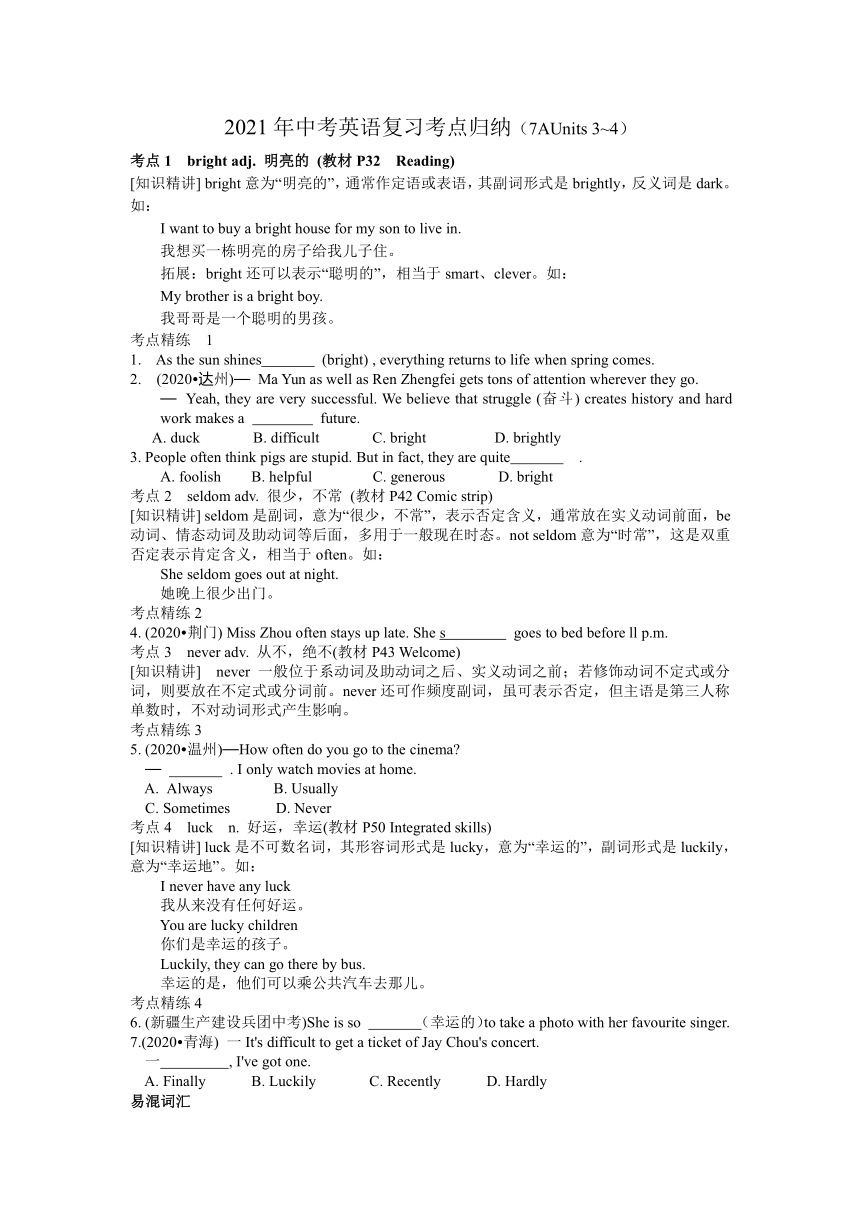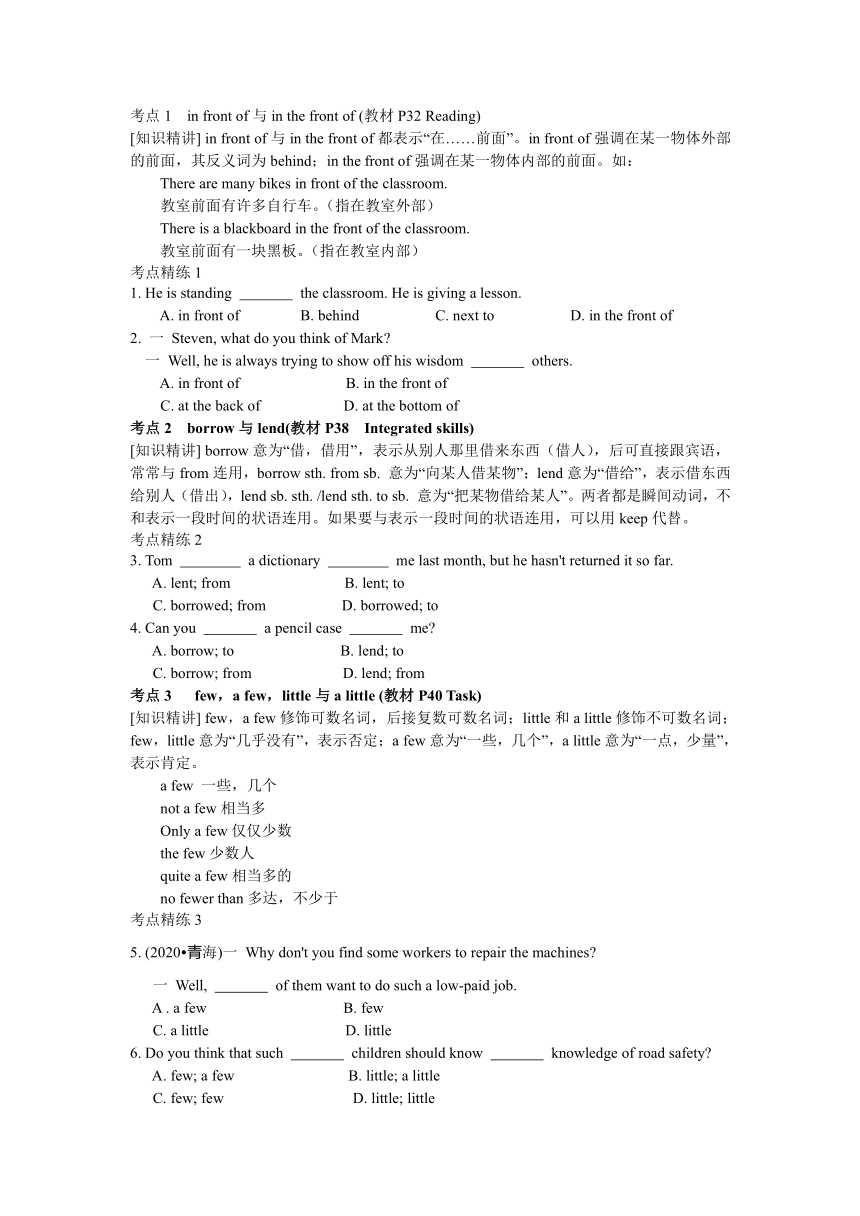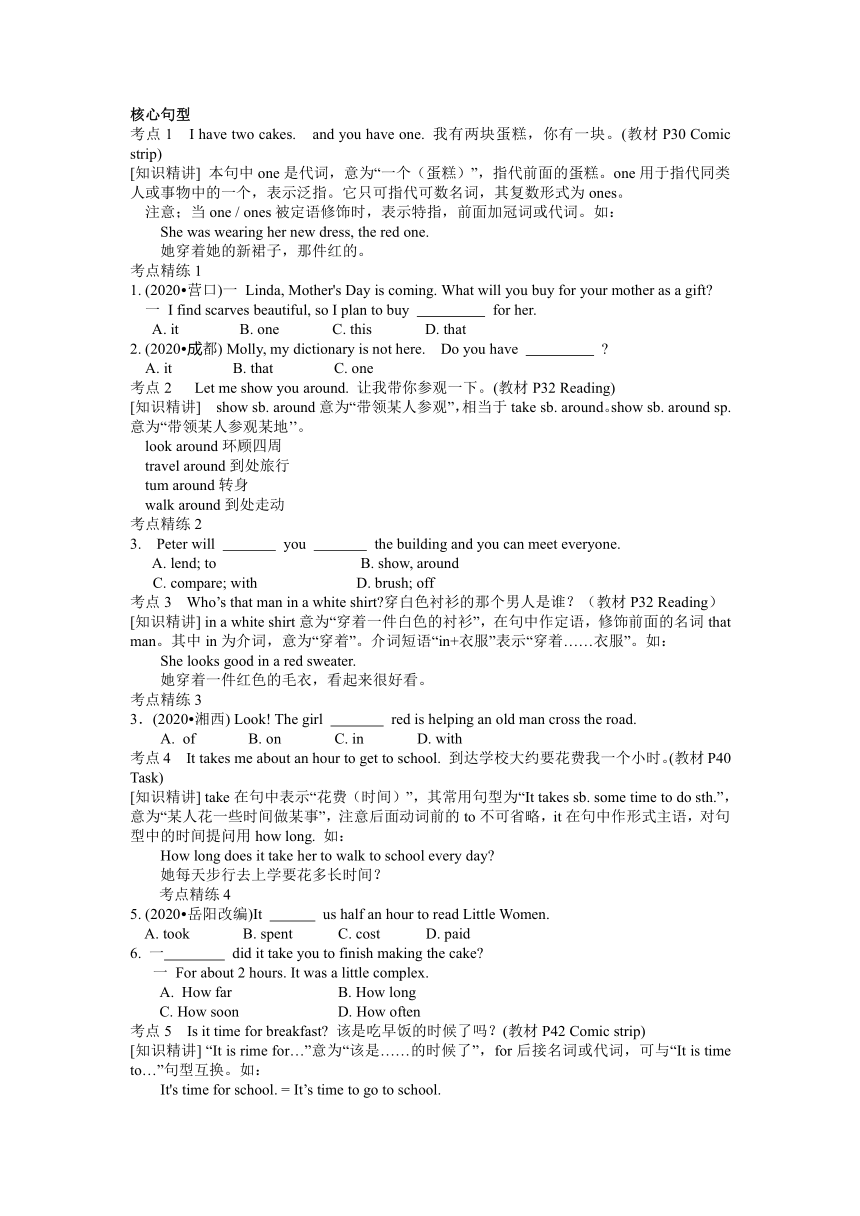2021年牛津译林版中考英语复习讲义(考点归纳及练习)(七年级上册Units 3~4)(含答案)
文档属性
| 名称 | 2021年牛津译林版中考英语复习讲义(考点归纳及练习)(七年级上册Units 3~4)(含答案) |  | |
| 格式 | doc | ||
| 文件大小 | 74.4KB | ||
| 资源类型 | 教案 | ||
| 版本资源 | 牛津译林版 | ||
| 科目 | 英语 | ||
| 更新时间 | 2021-03-09 22:19:02 | ||
图片预览



文档简介
2021年中考英语复习考点归纳(7AUnits 3~4)
考点1 bright adj. 明亮的 (教材P32 Reading)
[知识精讲] bright意为“明亮的”,通常作定语或表语,其副词形式是brightly,反义词是dark。如:
I want to buy a bright house for my son to live in.
我想买一栋明亮的房子给我儿子住。
拓展:bright还可以表示“聪明的”,相当于smart、clever。如:
My brother is a bright boy.
我哥哥是一个聪明的男孩。
考点精练 1
1. As the sun shines (bright) , everything returns to life when spring comes.
2. (2020?达州)— Ma Yun as well as Ren Zhengfei gets tons of attention wherever they go.
— Yeah, they are very successful. We believe that struggle (奋斗) creates history and hard work makes a future.
A. duck B. difficult C. bright D. brightly
3. People often think pigs are stupid. But in fact, they are quite .
A. foolish B. helpful C. generous D. bright
考点2 seldom adv. 很少,不常 (教材P42 Comic strip)
[知识精讲] seldom是副词,意为“很少,不常”,表示否定含义,通常放在实义动词前面,be动词、情态动词及助动词等后面,多用于一般现在时态。not seldom意为“时常”,这是双重否定表示肯定含义,相当于often。如:
She seldom goes out at night.
她晚上很少出门。
考点精练2
4. (2020?荆门) Miss Zhou often stays up late. She s goes to bed before ll p.m.
考点3 never adv. 从不,绝不(教材P43 Welcome)
[知识精讲] never 一般位于系动词及助动词之后、实义动词之前;若修饰动词不定式或分词,则要放在不定式或分词前。never还可作频度副词,虽可表示否定,但主语是第三人称单数时,不对动词形式产生影响。
考点精练3
5. (2020?温州)—How often do you go to the cinema?
— . I only watch movies at home.
Always B. Usually
C. Sometimes D. Never
考点4 luck n. 好运,幸运(教材P50 Integrated skills)
[知识精讲] luck是不可数名词,其形容词形式是lucky,意为“幸运的”,副词形式是luckily,意为“幸运地”。如:
I never have any luck
我从来没有任何好运。
You are lucky children
你们是幸运的孩子。
Luckily, they can go there by bus.
幸运的是,他们可以乘公共汽车去那儿。
考点精练4
6. (新疆生产建设兵团中考)She is so (幸运的)to take a photo with her favourite singer.
7.(2020?青海) 一It's difficult to get a ticket of Jay Chou's concert.
一 , I've got one.
A. Finally B. Luckily C. Recently D. Hardly
易混词汇
考点1 in front of与in the front of (教材P32 Reading)
[知识精讲] in front of与in the front of都表示“在……前面”。in front of强调在某一物体外部的前面,其反义词为behind;in the front of强调在某一物体内部的前面。如:
There are many bikes in front of the classroom.
教室前面有许多自行车。(指在教室外部)
There is a blackboard in the front of the classroom.
教室前面有一块黑板。(指在教室内部)
考点精练1
1. He is standing the classroom. He is giving a lesson.
A. in front of B. behind C. next to D. in the front of
2. 一 Steven, what do you think of Mark?
一 Well, he is always trying to show off his wisdom others.
A. in front of B. in the front of
C. at the back of D. at the bottom of
考点2 borrow与lend(教材P38 Integrated skills)
[知识精讲] borrow意为“借,借用”,表示从别人那里借来东西(借人),后可直接跟宾语,常常与from连用,borrow sth. from sb. 意为“向某人借某物”;lend意为“借给”,表示借东西给别人(借出),lend sb. sth. /lend sth. to sb. 意为“把某物借给某人”。两者都是瞬间动词,不和表示一段时间的状语连用。如果要与表示一段时间的状语连用,可以用keep代替。
考点精练2
3. Tom a dictionary me last month, but he hasn't returned it so far.
A. lent; from B. lent; to
C. borrowed; from D. borrowed; to
4. Can you a pencil case me?
A. borrow; to B. lend; to
C. borrow; from D. lend; from
考点3 few,a few,little与a little (教材P40 Task)
[知识精讲] few,a few修饰可数名词,后接复数可数名词;little和a little修饰不可数名词;few,little意为“几乎没有”,表示否定;a few意为“一些,几个”,a little意为“一点,少量”,表示肯定。
a few 一些,几个
not a few相当多
Only a few仅仅少数
the few少数人
quite a few相当多的
no fewer than多达,不少于
考点精练3
5. (2020?青海)一 Why don't you find some workers to repair the machines?
一 Well, of them want to do such a low-paid job.
A . a few B. few
C. a little D. little
6. Do you think that such children should know knowledge of road safety?
A. few; a few B. little; a little
C. few; few D. little; little
核心句型
考点1 I have two cakes. and you have one. 我有两块蛋糕,你有一块。(教材P30 Comic strip)
[知识精讲] 本句中one是代词,意为“一个(蛋糕)”,指代前面的蛋糕。one用于指代同类人或事物中的一个,表示泛指。它只可指代可数名词,其复数形式为ones。
注意;当one / ones被定语修饰时,表示特指,前面加冠词或代词。如:
She was wearing her new dress, the red one.
她穿着她的新裙子,那件红的。
考点精练1
1. (2020?营口)一 Linda, Mother's Day is coming. What will you buy for your mother as a gift?
一 I find scarves beautiful, so I plan to buy for her.
A. it B. one C. this D. that
2. (2020?成都) Molly, my dictionary is not here. Do you have ?
A. it B. that C. one
考点2 Let me show you around. 让我带你参观一下。(教材P32 Reading)
[知识精讲] show sb. around意为“带领某人参观”,相当于take sb. around。show sb. around sp.意为“带领某人参观某地’’。
look around环顾四周
travel around到处旅行
tum around转身
walk around到处走动
考点精练2
3. Peter will you the building and you can meet everyone.
A. lend; to B. show, around
C. compare; with D. brush; off
考点3 Who’s that man in a white shirt?穿白色衬衫的那个男人是谁?(教材P32 Reading)
[知识精讲] in a white shirt意为“穿着一件白色的衬衫”,在句中作定语,修饰前面的名词that man。其中in为介词,意为“穿着”。介词短语“in+衣服”表示“穿着……衣服”。如:
She looks good in a red sweater.
她穿着一件红色的毛衣,看起来很好看。
考点精练3
(2020?湘西) Look! The girl red is helping an old man cross the road.
of B. on C. in D. with
考点4 It takes me about an hour to get to school. 到达学校大约要花费我一个小时。(教材P40 Task)
[知识精讲] take在句中表示“花费(时间)”,其常用句型为“It takes sb. some time to do sth.”,意为“某人花一些时间做某事”,注意后面动词前的to不可省略,it在句中作形式主语,对句型中的时间提问用how long. 如:
How long does it take her to walk to school every day?
她每天步行去上学要花多长时间?
考点精练4
5. (2020?岳阳改编)It us half an hour to read Little Women.
A. took B. spent C. cost D. paid
6. 一 did it take you to finish making the cake?
一 For about 2 hours. It was a little complex.
How far B. How long
C. How soon D. How often
考点5 Is it time for breakfast? 该是吃早饭的时候了吗?(教材P42 Comic strip)
[知识精讲] “It is rime for…”意为“该是……的时候了”,for后接名词或代词,可与“It is time to…”句型互换。如:
It's time for school. = It’s time to go to school.
该是上学的时间了。
考点精练5
7. Please turn off the computer, Lily. It's time you to go to bed.
A. to B. from C. for D. in
重点语法
考点1 人称代词 (教材P35 Grammar)
[知识精讲] l1. 人称代词的定义:
人称代词是用来指代人的代词。在英语中往往第一次提到某人时用名字或名词,下文再提到该人时用人称代词来代替,一般不再重复名字或名词。
人称代词有主格和宾格两种形式,其人称形式的变化有第一人称、第二人称和第三人称;还有数的变化,即:单数和复数。其各种形式归纳如下
2.人称代词的用法:
(1)人称代词主格作主语,用在句首,位于谓语动词之前。如:
He is twelve years old.
他十二岁。
(2)人称代词宾格作宾浯,用在动词或介词之后。如:
I love them very much.
我非常爱他们。
(3)人称代词作表语时,多在书面语中用主格,在口语中用宾格。如:
一Who is it?
谁呀?
一 It is me(口语中)/ It is I .(书面语中)
是我。
人称代词的词序:
(l)单数人称中通常把I放在最后。在英语中为了显示对他人的尊敬,通常把别人放在前面。一般顺序为:you,he,she / it,I;但单数人称代词的顺序在表示承认错误或承担责任时,I应放在首位。如:
I and you are late for class.
我和你上课都迟到了。
(2)英语中复数人称代词的顺序为:we, you,they。
(3)两个第三人称同时出现时,一般遵循先男后女的原则,即把男性人称代词放在前面。如:
He and she are classmates. 他和她是同班同学。
考点精练1
1. (2020?淮安) My English teacher has a good sense of humour. We all like .
A. she B. her C. hers D. herself
2. (2020?青海)一 Mary and her classmates are busy preparing for their final examination.
一 That's why you can always see learning in the library.
A. them B. us C. her
3. (2020?黔南) Though the man is not handsome, is very clever.
A. its B. it C. he D. she
4. 一Jerry, is that boy with glasses new classmate?
一Yes. Let's say hello to .
A. our; he B. us; him
C. ours; his D. our; him
5. I have a lovely pet cat. name is Lazy.
A. It B. This C. Its D. She
6. (重庆中考B) Tom is my best friend. I often play basket-ball with .
A. he B. his C. him D. himself
7. 一 Listen! There's someone knocking at the door.
一Oh, must be Jim. It's time for him to get home now.
A. he B. this C. it D. that
8. (2020?天津) I bought a present for . I hope you like .
A. your; this B. yours; that
C. you, it D. you; one
9. (2020?邵阳) 一Do you like English?
一 Yes, but I think is a great challenge to learn the language well.
that B. this C. it
10. (2020?乐山) 一 Mary, is that girl in a red skirt our new roommate?
一 Yes. Let's go and say hello to .
she B. hers C. her
考点2 时间介词at / in / on的用法(教材P47 Grammar)
[知识精讲] 1. at用于节日/ 年龄/ 具体某一时刻/ 用餐时间等前面。如:at Christmas; at 18 years old; at six o'clock; at lunchtime; at midnight; at noon等。
2. in用于年份/ 季节/ 月份/ 世纪前,或泛指一天中的某部分。如:in 2010, in spring; in March; in the ninth century; in the morning/ afternoon/evening等。
3. on用于具体某一天(星期几或日期)/某天的上午、下午或晚上前面,指某天的上午、下午或晚上时,前面或后面应该有修饰成分。如:on Monday; on 16 June. 2016; on a snowy morning; on the evening of the Mid-Autumn Festival等。
考点精练2
11. (2020?镇江)China sent up the final satellite of BeiDou Navigation Satellite System(北斗卫星导航系统)from Xichang Satellite Launch Centre June 23, 2020.
A. at B. in C. to D. on
12. (2020?黔南)There is going to be an English movie in our school the evening of June 20.
A. at B. in C. for D. on
13. (2020?大庆)We have a Geography lesson three o'clock Thursday afternoon.
A. at; in B. in; in C. on; on D. at; on
14. Please meet me 8 o'clock this morning.
A. on B. in C. at D. for
考点3 频度副词(教材P48 Grammar)
[知识精讲]常见的频度副词有always,usually,often,sometimes,seldom,never等,它们常置于助动词之后、行为动词之前。这几个单词按“频率”高低排列如下:
always> usually>often> sometimes> seldom> never
注意以下几点用法:
1.对频度副词的提问,常用疑问短语how often。如;
Sometimes he goes to school on foot.(对画线部分提问)
How often does he go to school on foot?
2.频度副词一般位于系动词be之后,实义动词之前。但sometimes既可以放句中,也可以放句首,还可以放句末。如:
She is often late for school.
她经常上学迟到。
He usually goes to bed at about l0:00 p.m.
他通常晚上大约10点上床睡觉。
3.always可用于进行时中,带有感彩。如:
He is always talking in class.
他总是在课堂上讲话。
考点精练3
15. 一 How often do you usually go to work by subway?
一 . The subway in our city is really convenient.
A. Sometimes B. Never
C. Usually D. Seldom
16. (2020?南通)David is crazy about Chinese history. He visits the museums first wherever he travels in China.
A. never B. seldom
C. sometimes D. always
17. (2020?北京 )一 do you visit your grandparents, Tom?
一 Twice a month.
A. How much B. How often
C. How long D. How soon
考点1 bright adj. 明亮的 (教材P32 Reading)
[知识精讲] bright意为“明亮的”,通常作定语或表语,其副词形式是brightly,反义词是dark。如:
I want to buy a bright house for my son to live in.
我想买一栋明亮的房子给我儿子住。
拓展:bright还可以表示“聪明的”,相当于smart、clever。如:
My brother is a bright boy.
我哥哥是一个聪明的男孩。
考点精练 1
1. As the sun shines (bright) , everything returns to life when spring comes.
2. (2020?达州)— Ma Yun as well as Ren Zhengfei gets tons of attention wherever they go.
— Yeah, they are very successful. We believe that struggle (奋斗) creates history and hard work makes a future.
A. duck B. difficult C. bright D. brightly
3. People often think pigs are stupid. But in fact, they are quite .
A. foolish B. helpful C. generous D. bright
考点2 seldom adv. 很少,不常 (教材P42 Comic strip)
[知识精讲] seldom是副词,意为“很少,不常”,表示否定含义,通常放在实义动词前面,be动词、情态动词及助动词等后面,多用于一般现在时态。not seldom意为“时常”,这是双重否定表示肯定含义,相当于often。如:
She seldom goes out at night.
她晚上很少出门。
考点精练2
4. (2020?荆门) Miss Zhou often stays up late. She s goes to bed before ll p.m.
考点3 never adv. 从不,绝不(教材P43 Welcome)
[知识精讲] never 一般位于系动词及助动词之后、实义动词之前;若修饰动词不定式或分词,则要放在不定式或分词前。never还可作频度副词,虽可表示否定,但主语是第三人称单数时,不对动词形式产生影响。
考点精练3
5. (2020?温州)—How often do you go to the cinema?
— . I only watch movies at home.
Always B. Usually
C. Sometimes D. Never
考点4 luck n. 好运,幸运(教材P50 Integrated skills)
[知识精讲] luck是不可数名词,其形容词形式是lucky,意为“幸运的”,副词形式是luckily,意为“幸运地”。如:
I never have any luck
我从来没有任何好运。
You are lucky children
你们是幸运的孩子。
Luckily, they can go there by bus.
幸运的是,他们可以乘公共汽车去那儿。
考点精练4
6. (新疆生产建设兵团中考)She is so (幸运的)to take a photo with her favourite singer.
7.(2020?青海) 一It's difficult to get a ticket of Jay Chou's concert.
一 , I've got one.
A. Finally B. Luckily C. Recently D. Hardly
易混词汇
考点1 in front of与in the front of (教材P32 Reading)
[知识精讲] in front of与in the front of都表示“在……前面”。in front of强调在某一物体外部的前面,其反义词为behind;in the front of强调在某一物体内部的前面。如:
There are many bikes in front of the classroom.
教室前面有许多自行车。(指在教室外部)
There is a blackboard in the front of the classroom.
教室前面有一块黑板。(指在教室内部)
考点精练1
1. He is standing the classroom. He is giving a lesson.
A. in front of B. behind C. next to D. in the front of
2. 一 Steven, what do you think of Mark?
一 Well, he is always trying to show off his wisdom others.
A. in front of B. in the front of
C. at the back of D. at the bottom of
考点2 borrow与lend(教材P38 Integrated skills)
[知识精讲] borrow意为“借,借用”,表示从别人那里借来东西(借人),后可直接跟宾语,常常与from连用,borrow sth. from sb. 意为“向某人借某物”;lend意为“借给”,表示借东西给别人(借出),lend sb. sth. /lend sth. to sb. 意为“把某物借给某人”。两者都是瞬间动词,不和表示一段时间的状语连用。如果要与表示一段时间的状语连用,可以用keep代替。
考点精练2
3. Tom a dictionary me last month, but he hasn't returned it so far.
A. lent; from B. lent; to
C. borrowed; from D. borrowed; to
4. Can you a pencil case me?
A. borrow; to B. lend; to
C. borrow; from D. lend; from
考点3 few,a few,little与a little (教材P40 Task)
[知识精讲] few,a few修饰可数名词,后接复数可数名词;little和a little修饰不可数名词;few,little意为“几乎没有”,表示否定;a few意为“一些,几个”,a little意为“一点,少量”,表示肯定。
a few 一些,几个
not a few相当多
Only a few仅仅少数
the few少数人
quite a few相当多的
no fewer than多达,不少于
考点精练3
5. (2020?青海)一 Why don't you find some workers to repair the machines?
一 Well, of them want to do such a low-paid job.
A . a few B. few
C. a little D. little
6. Do you think that such children should know knowledge of road safety?
A. few; a few B. little; a little
C. few; few D. little; little
核心句型
考点1 I have two cakes. and you have one. 我有两块蛋糕,你有一块。(教材P30 Comic strip)
[知识精讲] 本句中one是代词,意为“一个(蛋糕)”,指代前面的蛋糕。one用于指代同类人或事物中的一个,表示泛指。它只可指代可数名词,其复数形式为ones。
注意;当one / ones被定语修饰时,表示特指,前面加冠词或代词。如:
She was wearing her new dress, the red one.
她穿着她的新裙子,那件红的。
考点精练1
1. (2020?营口)一 Linda, Mother's Day is coming. What will you buy for your mother as a gift?
一 I find scarves beautiful, so I plan to buy for her.
A. it B. one C. this D. that
2. (2020?成都) Molly, my dictionary is not here. Do you have ?
A. it B. that C. one
考点2 Let me show you around. 让我带你参观一下。(教材P32 Reading)
[知识精讲] show sb. around意为“带领某人参观”,相当于take sb. around。show sb. around sp.意为“带领某人参观某地’’。
look around环顾四周
travel around到处旅行
tum around转身
walk around到处走动
考点精练2
3. Peter will you the building and you can meet everyone.
A. lend; to B. show, around
C. compare; with D. brush; off
考点3 Who’s that man in a white shirt?穿白色衬衫的那个男人是谁?(教材P32 Reading)
[知识精讲] in a white shirt意为“穿着一件白色的衬衫”,在句中作定语,修饰前面的名词that man。其中in为介词,意为“穿着”。介词短语“in+衣服”表示“穿着……衣服”。如:
She looks good in a red sweater.
她穿着一件红色的毛衣,看起来很好看。
考点精练3
(2020?湘西) Look! The girl red is helping an old man cross the road.
of B. on C. in D. with
考点4 It takes me about an hour to get to school. 到达学校大约要花费我一个小时。(教材P40 Task)
[知识精讲] take在句中表示“花费(时间)”,其常用句型为“It takes sb. some time to do sth.”,意为“某人花一些时间做某事”,注意后面动词前的to不可省略,it在句中作形式主语,对句型中的时间提问用how long. 如:
How long does it take her to walk to school every day?
她每天步行去上学要花多长时间?
考点精练4
5. (2020?岳阳改编)It us half an hour to read Little Women.
A. took B. spent C. cost D. paid
6. 一 did it take you to finish making the cake?
一 For about 2 hours. It was a little complex.
How far B. How long
C. How soon D. How often
考点5 Is it time for breakfast? 该是吃早饭的时候了吗?(教材P42 Comic strip)
[知识精讲] “It is rime for…”意为“该是……的时候了”,for后接名词或代词,可与“It is time to…”句型互换。如:
It's time for school. = It’s time to go to school.
该是上学的时间了。
考点精练5
7. Please turn off the computer, Lily. It's time you to go to bed.
A. to B. from C. for D. in
重点语法
考点1 人称代词 (教材P35 Grammar)
[知识精讲] l1. 人称代词的定义:
人称代词是用来指代人的代词。在英语中往往第一次提到某人时用名字或名词,下文再提到该人时用人称代词来代替,一般不再重复名字或名词。
人称代词有主格和宾格两种形式,其人称形式的变化有第一人称、第二人称和第三人称;还有数的变化,即:单数和复数。其各种形式归纳如下
2.人称代词的用法:
(1)人称代词主格作主语,用在句首,位于谓语动词之前。如:
He is twelve years old.
他十二岁。
(2)人称代词宾格作宾浯,用在动词或介词之后。如:
I love them very much.
我非常爱他们。
(3)人称代词作表语时,多在书面语中用主格,在口语中用宾格。如:
一Who is it?
谁呀?
一 It is me(口语中)/ It is I .(书面语中)
是我。
人称代词的词序:
(l)单数人称中通常把I放在最后。在英语中为了显示对他人的尊敬,通常把别人放在前面。一般顺序为:you,he,she / it,I;但单数人称代词的顺序在表示承认错误或承担责任时,I应放在首位。如:
I and you are late for class.
我和你上课都迟到了。
(2)英语中复数人称代词的顺序为:we, you,they。
(3)两个第三人称同时出现时,一般遵循先男后女的原则,即把男性人称代词放在前面。如:
He and she are classmates. 他和她是同班同学。
考点精练1
1. (2020?淮安) My English teacher has a good sense of humour. We all like .
A. she B. her C. hers D. herself
2. (2020?青海)一 Mary and her classmates are busy preparing for their final examination.
一 That's why you can always see learning in the library.
A. them B. us C. her
3. (2020?黔南) Though the man is not handsome, is very clever.
A. its B. it C. he D. she
4. 一Jerry, is that boy with glasses new classmate?
一Yes. Let's say hello to .
A. our; he B. us; him
C. ours; his D. our; him
5. I have a lovely pet cat. name is Lazy.
A. It B. This C. Its D. She
6. (重庆中考B) Tom is my best friend. I often play basket-ball with .
A. he B. his C. him D. himself
7. 一 Listen! There's someone knocking at the door.
一Oh, must be Jim. It's time for him to get home now.
A. he B. this C. it D. that
8. (2020?天津) I bought a present for . I hope you like .
A. your; this B. yours; that
C. you, it D. you; one
9. (2020?邵阳) 一Do you like English?
一 Yes, but I think is a great challenge to learn the language well.
that B. this C. it
10. (2020?乐山) 一 Mary, is that girl in a red skirt our new roommate?
一 Yes. Let's go and say hello to .
she B. hers C. her
考点2 时间介词at / in / on的用法(教材P47 Grammar)
[知识精讲] 1. at用于节日/ 年龄/ 具体某一时刻/ 用餐时间等前面。如:at Christmas; at 18 years old; at six o'clock; at lunchtime; at midnight; at noon等。
2. in用于年份/ 季节/ 月份/ 世纪前,或泛指一天中的某部分。如:in 2010, in spring; in March; in the ninth century; in the morning/ afternoon/evening等。
3. on用于具体某一天(星期几或日期)/某天的上午、下午或晚上前面,指某天的上午、下午或晚上时,前面或后面应该有修饰成分。如:on Monday; on 16 June. 2016; on a snowy morning; on the evening of the Mid-Autumn Festival等。
考点精练2
11. (2020?镇江)China sent up the final satellite of BeiDou Navigation Satellite System(北斗卫星导航系统)from Xichang Satellite Launch Centre June 23, 2020.
A. at B. in C. to D. on
12. (2020?黔南)There is going to be an English movie in our school the evening of June 20.
A. at B. in C. for D. on
13. (2020?大庆)We have a Geography lesson three o'clock Thursday afternoon.
A. at; in B. in; in C. on; on D. at; on
14. Please meet me 8 o'clock this morning.
A. on B. in C. at D. for
考点3 频度副词(教材P48 Grammar)
[知识精讲]常见的频度副词有always,usually,often,sometimes,seldom,never等,它们常置于助动词之后、行为动词之前。这几个单词按“频率”高低排列如下:
always> usually>often> sometimes> seldom> never
注意以下几点用法:
1.对频度副词的提问,常用疑问短语how often。如;
Sometimes he goes to school on foot.(对画线部分提问)
How often does he go to school on foot?
2.频度副词一般位于系动词be之后,实义动词之前。但sometimes既可以放句中,也可以放句首,还可以放句末。如:
She is often late for school.
她经常上学迟到。
He usually goes to bed at about l0:00 p.m.
他通常晚上大约10点上床睡觉。
3.always可用于进行时中,带有感彩。如:
He is always talking in class.
他总是在课堂上讲话。
考点精练3
15. 一 How often do you usually go to work by subway?
一 . The subway in our city is really convenient.
A. Sometimes B. Never
C. Usually D. Seldom
16. (2020?南通)David is crazy about Chinese history. He visits the museums first wherever he travels in China.
A. never B. seldom
C. sometimes D. always
17. (2020?北京 )一 do you visit your grandparents, Tom?
一 Twice a month.
A. How much B. How often
C. How long D. How soon
